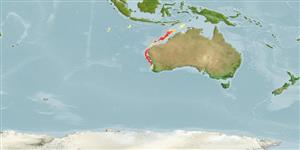Classification / Names
ชื่อสามัญ | ชื่อพ้อง | Catalog of Fishes(สกุล, ชนิด) | ITIS | CoL | WoRMS | Cloffa
sub class Elasmobranchii (ฉลามและกระเบน) (sharks and rays) >
Carcharhiniformes (Ground sharks) >
Scyliorhinidae (Cat sharks) > Scyliorhininae
Etymology: Cephaloscyllium: cephalus, from kephale (Gr.), head, referring to its very broad and depressed head; skylion, Greek for dogfish or small shark. (See ETYFish); speccum: From specca (L.), speckled, referring to dark brown spots and blotches that dominate its color pattern. (See ETYFish).
More on authors: Last, Séret & White.
Environment: milieu / climate zone / depth range / distribution range
นิเวศวิทยา
เกี่ยวกับทะเล,น้ำเค็ม กลุ่มสัตว์หน้าดิน,กลุ่มสัตว์พื้นท้องน้ำ; ระดับความลึก 150 - 455 m (Ref. 76946). Tropical
Eastern Indian Ocean: Australia.
Length at first maturity / ขนาด / น้ำหนัก / Age
Maturity: Lm ?, range 64 - ? cm
Max length : 68.0 cm TL เพศผู้/กระเทย; (Ref. 76946); 69.4 cm TL (female)
Short description
สัณฐานวิทยา | ความยาวต่างๆ
A medium-sized species with the following characters: head 7.8-12.5% TL in height, trunk width 13.0-16.8% TL; origin of first dorsal-fin mostly over posterior of pelvic-fin base; prenarial 3.6-4.9% TL in length; preorbital snout length 1.5-2.0 times prenarial length, 2.6-3.1 in prepectoral length, 5.9-7.1 in prepelvic length; snout-vent length long, 47.4-51.1% TL; nostril 2.2-2.7% TL in width; eye-spiracle space narrow, 0.4-1.0% TL; pectoral fin medium-sized, height 8.9-13.8% TL, posterior margin 8.5-13.3% TL; anal fin tall, 3.2-4.4% TL; anal-caudal space 4.5-6.1% TL; precaudal 76-78% TL in length; interdorsal space 6.5-8.6% TL; teeth have 3-5 cusps; unicuspidate or weakly tricuspidate flank denticles; back with no greatly enlarged denticles; adult clasper long, outer length about 7% TL, well short of anal fin, interspace about 1.9% TL; vertebral centra 111-115; tooth count relatively high, 69-97 teeth in each jaw; color of upper half of body pale, with a strongly variegated pattern that is well-demarcated from the ventral surface; dark saddles (8) evident on body and caudal fin; pale variegated dorsal fins; dark blotch over gills absent; distinct V-shaped marking on posterior margin of terminal lobe of caudal fin absent; upper surfaces of pectoral and pelvic-fin without a dark central blotch; without dark saddle extending onto caudal peduncle above origin of ventral lobe of caudal fin; uniformly pale on the ventral surface; color of juveniles pale, with dark lines and spots forming rosettes and linear saddle markings, and the markings between spiracles separated into two unconnected pseudo-ocelli (Ref. 76946).
Life cycle and mating behavior
วัยเจริญพันธุ์ | การสืบพันธุ์ | การวางไข่ | เซลสืบพันธ์ของเพศเมีย(ไข่) | ความดกของไข่ | ตัวอ่อน
Last, P.R., B. Séret and W.T. White, 2008. New swellsharks (Cephaloscyllium: Scyliorhinidae) from the Indo-Australian region. In Last, P.R., White, W.T. & Pogonoski, J.J. (eds.): Descriptions of New Australian Chondrichthyans. CSIRO Marine and Atmospheric Research Paper no. 22. (Ref. 76946)
IUCN Red List Status (Ref. 130435)
Threat to humans
Harmless
Human uses
ข้อมูลเพิ่มเติม
ชื่อสามัญชื่อพ้องกลไกการเผาผลาญพลังงานผู้ล่าการศึกษาเกี่ยวกับผลกระทบของสารประกอบทางเคมีที่เป็นอันตรายต่อสิ่งมีชีวิต ประชากร และสิ่งแวดล้อมการสืบพันธุ์วัยเจริญพันธุ์การวางไข่การรวมกลุ่มวางไข่ความดกของไข่เซลสืบพันธ์ของเพศเมีย(ไข่)Egg development
Age/SizeการเจริญเติบโตLength-weightLength-lengthLength-frequenciesความยาวต่างๆสัณฐานวิทยาตัวอ่อนพลวัตของสัตว์น้ำวัยอ่อนการทดแทนที่อุดมสมบรูณ์BRUVS
อ้างอิงการเพาะเลี้ยงสัตว์น้ำประวัติการเพาะเลี้ยงสัตว์น้ำสายพันธุ์พันธุศาสตร์ElectrophoresesอัตราพันธุกรรมโรคการแปรรูปNutrientsMass conversion
ผู้ร่วมมือรูปภาพหลายรูปStamps, Coins Misc.เสียงปลามีพิษ เช่น ปลาปักเป้าความเร็วรูปแบบการว่ายน้ำพื้นที่เหงือกOtolithsสมองวิสัยทัศน์
เครื่องมือ
Special reports
Download XML
แหล่งที่มาจากอินเตอร์เน็ต
Estimates based on models
Preferred temperature (Ref.
123201): 11.4 - 16.5, mean 13.4 °C (based on 21 cells).
Phylogenetic diversity index (Ref.
82804): PD
50 = 0.5000 [Uniqueness, from 0.5 = low to 2.0 = high].
Bayesian length-weight: a=0.00263 (0.00139 - 0.00497), b=3.21 (3.04 - 3.38), in cm total length, based on LWR estimates for this (Sub)family-body shape (Ref.
93245).
ระดับชั้นอาหาร (Ref.
69278): 4.1 ±0.5 se; based on size and trophs of closest relatives
ความสามารถในการกลับคืนสู่ปกติ (Ref.
120179): ต่ำ, เวลาต่ำสุดที่จะทำให้ประชากรเพิ่มขึ้นเป็น 2 เท่าใช้เวลา 4.5 - 14 ปี (Preliminary low fecundity).
Fishing Vulnerability (Ref.
59153): Moderate to high vulnerability (48 of 100).
